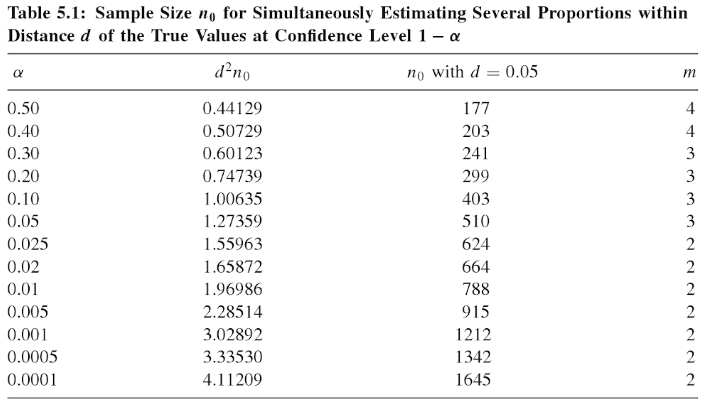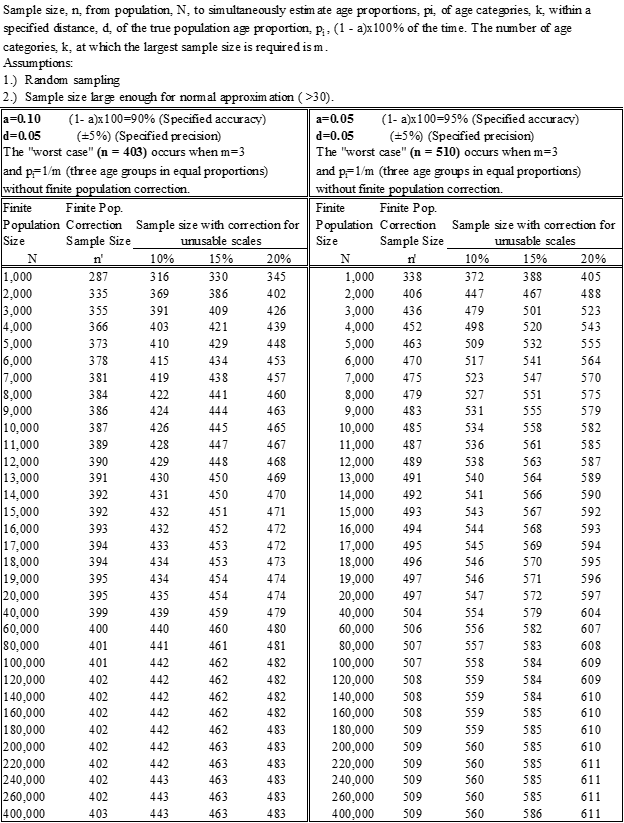Sample Size and Rate
Last modified on Jul 09, 2020
Salmon scales, sex, weight, and length are sampled by ADF&G crews throughout Alaska. Salmon scales are taken to estimate the age composition of a given stock each year. Multiple years of age composition data are used to construct brood tables that help create spawning escapement goals and pre-season forecasts. Below are recommended methods for determining sample size and collecting an unbiased sample.
Sample size
Scales are sampled to estimate the proportion of fish in each age group and to estimate the age composition of the population. Age composition is a multinomial proportion, so the minimum sample size to simultaneously estimate several proportions depends on the acceptable margin of error d, and the level of confidence a (Thompson, 1987). For example, a sample size of 510 readable scales is needed to estimate age composition within 5% of the true proportion 95% of the time (Table 5.1 from Thompson 1987).
Source: Thompson (1987).
The necessary sample size (n') can be determined by using a rough estimate of the population size (N) in conjunction with the desired level of accuracy, precision, knowledge of the proportion of possible age classes, and the estimated proportion of unusable scales that will be collected. The table below shows that the finite population correction sample size necessary, n', trends towards 510 at an accuracy of 95% and a precision of 5%, prior to accounting for unusable scales. However, the sample size increases to 611 scales if the proportion of unusable scales is 20%:
We recommend that Chinook salmon sampling programs strive to achieve an accuracy of 95% and a precision of 5%. Thus, given that the proportion of unreadable scales collected by ADF&G samplers is generally less than 20% of a total sample, a representative sample size of approximately 611 fish would achieve this. However, if temporal trends are being examined (e.g. across the season), this number may need to be collected for each stratum sampled.
Sampling the population
Careful consideration needs to be made to collect a sample that is representative of the larger population and weighting age compositions in accordance with harvest and/or escapement. For example, a sample of 600 fish for a harvest of 10,000 Chinook needs to be weighted proportionally higher in an age composition than a sample of 600 fish from a harvest of only 1,000 fish.
For a location where the fish abundance has only natural variation, such as at a counting tower or weir, the simplest method for collecting an unbiased selection of fish is to collect a systematic sample (Thompson 2002). One way to collect a systematic sample would be to sample every 10th fish. This would provide a sampling ratio of 1 in 10. In 2015, sockeye salmon were sampled with a sampling ratio of 1 in 61 in Fish Creek (Hayes and Lescanec 2016). Another method is to sample every other day or once per week, depending on expected abundance and target sample size. Each year's return is not known until the run is complete, so the previous years' abundance or projected return is usually used as a guideline.
Where fish abundance is influenced by fishing periods, fishing pressure, or gear type (i.e.; not all fish have the same probability of capture), then the simplest method for an unbiased estimate is to stratify samples by category, such as spatial (statistical areas) or temporal (week or harvest period) groups (Thompson 2002). The age composition is weighted by the abundance in these strata. If age composition is not weighted by these strata and instead is treated equally, then the age composition will be biased toward the least abundant strata. Note that other sampling approaches are possible, such as cluster and double sampling (Thompson 2002).
Scales per fish
Throughout Alaska, at least three (and up to ten) Chinook salmon scales are collected per fish. Collecting multiple scales per fish decreases the chance that sampled scales will be regenerated, resorbed, or have a deformity preventing age estimation. Chinook salmon exhibit robust growth throughout their long life (Groot 2010), which makes multiple scales from each fish useful when estimating age. The total run of Chinook salmon can be small during a year, thus age data from each fish is extremely valuable. We recommend that a minimum of 3 scales be collected from each Chinook salmon sampled.
More scales should be collected when the sampling conditions do not allow inspection for regenerated scales or when the preferred area of the fish cannot be sampled.
Non-readable samples
Although multiple scales are sampled per fish and careful preparation used, not all sampled fish can be aged. The proportion of unreadable scales in a sample can be as high as 50% but, ideally, is less than 15%. For the purpose of determining a sample size (see above), an estimate for the proportion of unreadable scales should come from previous years' sampling results and be included when determining sample size. It is not always possible in the field to identify unreadable scales, thus we encourage scale samplers to learn the appearance of regenerated scales to prevent collection of unreadable scales.
References
Hayes, S., and D. Lescanec. 2016. Operational Plan: Fish Creek Sockeye and Coho Salmon Escapement, 2015. Alaska Department of Fish and Game, Regional Operational Plan ROP.SF.2A.2015.15, Anchorage.
Thompson, S. K. 2002. Sampling, Second Edition. Wiley, New York.


